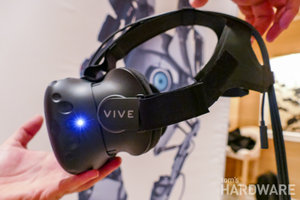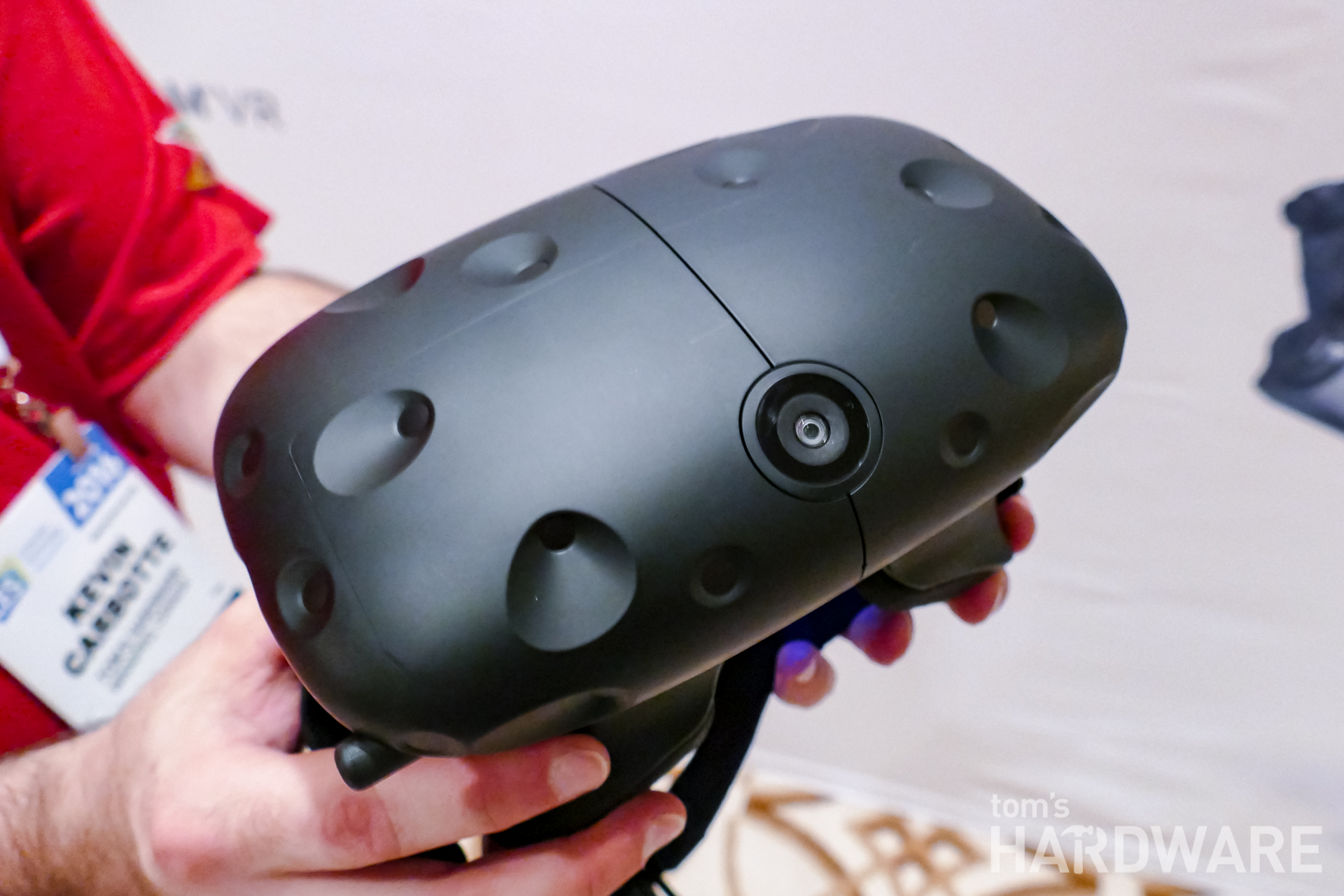The Vive Pre, HTC’s New VR Developer Kit: First Look
HTC’s Vive was originally scheduled to be released at the tail end of 2015, but weeks before the end of the year, the company announced that it would be delaying the launch until April. HTC cited a “really big breakthrough” as the reason for the delay but would not discuss what that would be. Now that we’re at CES 2016, we’ve had the chance to try the new Vive, and the company wasn’t kidding about the added benefits of its latest revision.
The version of Vive that HTC is showing off this week is being called Vive Pre (aka, the VK2). It features a number of improvements over the previous developer kit, and it will be shipping to developers later this month.
"Tron Mode"
One of the first things you’ll notice about the new Vive headset is the camera mounted on the lower front of the HMD. This camera is the basis of the “breakthrough” that HTC hinted at last month. The camera is used to bring real objects into view while you’re wearing the headset, though I wouldn’t really call this AR per se. HTC is using this feature as an extension of the chaperone system, which is used to map the barriers of the room scale tracking area. With the camera, HTC is able to present a blue wireframe outline of the objects and even people in the room. Some of the editors at Tom’s Hardware have dubbed this “Tron Mode,” which actually describes what you see fairly well.
To enable this feature, you double tap the button on the controller located below the track pad. The game world will disappear, and as you approach the chaperone limits, the wireframe view of objects outside of the limits will come into view. The objects aren’t very clear, but they are clear enough to identify.
I was able to identify a painting on the wall, the stands that the lighthouse trackers were attached to, and the people in the room. The details are vague to say the least, but it gives you more than enough information to interact with things without taking the headset off. The view is rather blurry, but it was good enough to make out the important details. I was even able to read my name on my press badge.
HTC’s JB Mcree told us that this feature will enable you to locate your keyboard or extra peripherals, such as a wheel for racing games or HOTAS for flight simulators. You can also locate furniture with the HMD over your eyes, allowing you to transition from standing to sitting experiences without taking the Vive off. To demonstrate this feature, Mcree pulled a chair into my play area and simply told me to sit down on it. I was able to clearly make out the chair and sit on it without any trouble, which was simply not possible on the previous version of the Vive.
Comfort And Ergonomics
HTC made other improvements to the Vive Pre that are supposed make it more comfortable. Mcree told us that the new design features a brighter screen that improves the clarity of the display. The headset is also a little bit more compact, which brings the screen slightly closer to your eyes. The head strap has also been improved upon. It now includes an additional strap that fits lower on the back of your head, which should help distribute the weight more evenly. The Vive Pre also features removable face gaskets. HTC said there will be two sizes of gasket to accommodate different size faces.
Get Tom's Hardware's best news and in-depth reviews, straight to your inbox.
The Vive controllers have been completely redesigned. HTC said the improvements focused on ergonomics and balance. The new controllers feel much more comfortable in your hands, and the build quality feels much more refined as well.


The new controllers feature an open ring at the top, which houses the lighthouse sensors. At first glance, the ring at the top appears as though it would enable finger tracking similar to Oculus Touch, but when we asked about it, we were told the Vive controllers don’t have that ability.
The buttons on the new controllers have texture to them to make it easier to locate. The two grip pads on the sides of the controllers have been improved to be more comfortable in your hands. The trigger grips have also been updated with a dual-stage action similar to the ones found on the Steam controller.
HTC added integrated lithium polymer batteries to the Vive Pre controllers. We were told the batteries have enough capacity be used for over 4 hours on a single charge. A microUSB charge port is found on the bottom of the controllers.
Valve’s lighthouse base stations have also been refined. The new units are smaller than the previous iteration, and HTC said they offer improved tracking ability. The company noted that the base stations are quieter than the old version. We were also told that the new base stations feature standard camera tripod threading, so they can be set up on a tripod for less permanent installation.
HTC implemented what it called Mura correction, a way to improve the clarity of the HMD displays. Valve exec Chet Faliszek was unwilling to talk about exactly how Mura correction worked in a conversation with Tom's Hardware, other than to say that it involved every aspect of the display system, nor would he address whether the technology had any impact on system latency. However our experience with the demonstration certainly brought home the improvement in display quality. The VR demos we saw were easily more clear than other Vive demos we've seen, especially comparing WEVR's theBlu which we've now seen on the previous Vive, and now on the Vive Pre. HTC and Valve called this a "breakthrough" that others have tried with prototype add-on filters, but this is the first time -- according to the companies -- that it's been building into a working HMD.
7,000 Vive Pre Units
HTC and Valve will be shipping out 7,000 Vive Pre systems to developers later this month. We asked how a developer would go about getting one of those kits, but Mcree told us those details are still being ironed out. The developers that have already been working with Vive developer kits will have priority. HTC confirmed that some of these kits have already been delivered to developers -- namely, those that have working demos at CES 2016.
The company was not willing to discuss anything about the upcoming retail version of the hardware at our meeting. The retail release is still scheduled for April, so it won’t be long before we start hearing those details. Pricing was also not discussed, but Mcree stated that HTC is focusing on making the most premium home VR experience possible, which the final price will likely reflect.
Follow Kevin Carbotte @pumcypuhoy. Follow us on Facebook, Google+, RSS, Twitter and YouTube.
Kevin Carbotte is a contributing writer for Tom's Hardware who primarily covers VR and AR hardware. He has been writing for us for more than four years.
-
Oldbutstillatit @ 16:40 keys clickity clack, turn the monitor and the little magic blue screen on the (now turned monitor) is gone. #sighReply
Thank you Tom's for the video and the article. I love this site, for years! -
Oldbutstillatit Hmmm......double post? Anyway, Thanks Tom's for the article and video. @ 16:40 they realise we can all see (those like me that look for it) and clickity clack, twist and poof. The magic blue screen is gone.Reply -
bit_user Reply
Thanks, but it's unfortunate the HMD view wasn't on the screen in the background. Few things are more boring than watching someone having a VR experience from the outside.17262159 said:...
-
kcarbotte Reply17273198 said:
Thanks, but it's unfortunate the HMD view wasn't on the screen in the background. Few things are more boring than watching someone having a VR experience from the outside.17262159 said:...
HTC would not let us film the computer or the screen displaying the game.
It would be nice to be able to show everyone what I was seeing but the company was very strict about that. I actually got a couple shots with the screen without noticing and JB Mcree tapped me on the sholder and asked me to change angles.
-
Keng Yuan ReplyWe asked how a developer would go about getting one of those kits, but Mcree told us those details are still being ironed out.
Too little, too late. -
kcarbotte Reply17319892 said:We asked how a developer would go about getting one of those kits, but Mcree told us those details are still being ironed out.
Too little, too late.
The VR industry is just getting started.
its far from too late.



